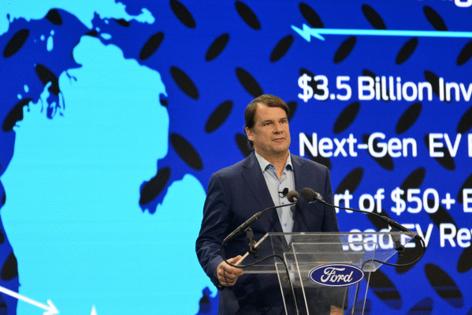Ford forecasts lower 2025 earnings. Here's why
Published in Automotive News
Ford Motor Co. will cut costs, improve electric vehicle volumes and invest more in its future in 2025, but it's expecting pricing pressures to weigh on annual financial results.
The Dearborn, Michigan, automaker forecasted adjusted operating income of $7 billion to $8.5 billion, down from the $10.2 billion it recorded Wednesday for 2024, even before factoring in potential tariffs or changes to tax credits related to plug-in vehicles. Although Ford is betting updated products like the Ford Expedition and Lincoln Navigator and $1 billion in net cost reductions will help this year's results, it expects pricing in the industry to be off by 2%.
Last week, crosstown rival General Motors Co., which expects improved earnings in 2025 compared to 2024, also forecasted pricing declines in the United States — of 1-1.5% through incentives or average transaction prices.
Pricing challenges especially are going to be visible with electric vehicles, John Lawler, Ford's chief financial officer and vice chair, said during a call with reporters. Ford's Model e EV division is once again expecting to lose $5 billion to $5.5 billion in 2025 after losing more than $5 billion last year.
"There are a lot of new nameplates that will be coming into the market this year, and so it's just basic supply and demand," Lawler said. "Demand is not growing as quickly. There's going to be a lot more supply that's going to continue to put pressure on the top line."
Like in 2024, when Ford saw net income increase 37% year-over-year to $5.9 billion on record annual revenue that beat Wall Street expectations, the company hopes to offset those pressures with cost reductions, mostly in warranty and material costs.
The desired $1 billion improvement would represent the company's lowest cost performance since 2009, excluding the COVID-impacted 2020, said Sherry House, Ford's vice president of finance who is set to take over from Lawler as CFO on Thursday. The company posted $1.4 billion in net cost reductions in Model e in 2024.
The fourth quarter of 2024 saw improvement of $500 million in warranty costs over the third quarter, House said. CEO Jim Farley said there has been an 18% improvement in the quality of vehicles for the '25 model launches, and Ford is also leveraging artificial intelligence for cost improvements.
Get the Michigan Politics newsletter in your inbox.
Washington and Lansing, red and blue, we've got your government covered.
Delivery: Daily
Your Email
Additionally, new electric product launches in Europe and increased EV volumes will help, House said. If not eliminated under Trump, the Inflation Reduction Act's production tax credits for EV batteries manufactured in the United States from Ford's first joint-venture plant with Korean partner SK On Ltd. in Kentucky, which is expected to launch this year, will offer some help, she added.
The company also is forecasting $8 billion to $9 billion in capital expenditures in 2025. The guidance includes $1 billion in investments for its next-generation EVs, up more than $500 million year over year. A new all-electric commercial van is due next year, followed by electric midsize and full-size trucks in 2027.
"We are seeing the real benefits of the cost improvement that we made last year," House said.
Farley confirmed during an earnings call that Ford is developing flexible body-on-frame and unit-body platforms that will support multi-energy powertrains, including hybrid and extended-range electric vehicles. This is to support customer affordability concerns and range needs, he said.
The unknowns, however, are big. Trump has ordered his administration reevaluate incentives for EVs, which could include removal of the up to $7,500 consumer tax credit on plug-in vehicles that's part of the IRA.
"In this kind of environment, the skunkworks platform becomes more important," Farley said about the company's next-generation EVs. "More affordable in the actual cost of the vehicle becomes more important, not less."
This week, Trump also paused instituting 25% tariffs on Mexico and Canada until March; a 10% duty on China was implemented.
Ford isn't taking any action related to the potential Canada and Mexico tariffs and is moving forward with the launch of Super Duty trucks in Ontario's Oakville Assembly Complex, House said. It's also evaluating the situation with China, where it produces the Lincoln Nautilus SUV.
Added Farley: "We can make sure nothing crosses the border for a couple weeks. We have good stock situation in our dealers right now."
He emphasized the need for fairness with tariffs, if they are instituted, calling out Korean and Japanese competitors for importing hundreds of thousands of vehicles in the United States from their home countries.
"There are millions of vehicles coming into our country that are not being applied to these, so if we're going to have a tariff policy to last for a month or ... years, it better be comprehensive for our industry," Farley said. "We can't just cherry pick one place or the other, because this is a bonanza for our import competitors."
Based on the adjusted operating income, about 47,000 U.S. hourly autoworkers are eligible for profit sharing of approximately $10,208 based on the agreement with the United Auto Workers, though the amount could be above or below that depending on compensated hours. Employees will see the bonus in their March 13 paycheck.
Ford, in 2024, posted revenue of $185 billion, up 5% from 2023. Although the operating profit fell 1.9% and the margin was down from 5.9%, Ford still finished above its $10 billion forecast and surpassed average analyst predictions, according to Yahoo Finance.
Analysts were expecting revenue of $175 billion and earnings of $1.79 per share. Ford recorded adjusted earnings per share of $1.85 for the year. Its stock, however, was traded down 6.3% mid-morning Thursday.
The Blue Oval also forecasted first-quarter operating earnings to be break-even because of lower volumes and unfavorable product mix related to launches at Kentucky Truck and Michigan Assembly plants. Circumstances are expected to become more normal in the second quarter, House said.
Ford achieved a $1.8 billion net income in the last three months of 2024, reversing a half-a-billion-dollar loss from the year prior on $48.2 billion in revenue, which was up 5%. Adjusted operating income for the quarter was up 91% to $2.1 billion.
"It's one step forward and two steps back," said Daniel Ives, an analyst at investment firm Wedbush Securities Inc. "The quarter was good, but it's tough sledding for 2025. It's a disappointing guidance, which is prudent in light of a lot of the moving parts, including tariffs."
The falling after-hours stock price is "ugly" for Ford, said David Whiston, an analyst at financial services firm Morningstar Inc. But GM's shares fell almost 9% after its reported results last week.
"Maybe the market finds Ford’s 2025 guidance more realistic whereas GM’s seems to have been taken as a best-case scenario even if no tariff/EV credits," Whiston said in an email. "Ford continues to need to cut costs as their profit metrics trail GM’s. No improvement in Model e EBIT expected either probably is disappointing to some investors but that’s still a very young business with lots of investment still to be made."
Last year, Ford Blue, the company's internal combustion engine and hybrid vehicle business, posted operating income down 29% to $5.284 billion and a 5.2% operating margin. The automaker had predicted $5 billion in earnings from Ford Blue after decreasing the outlook twice last year.
It expects $3.5 billion to $4 billion in operating earnings from Ford Blue in 2025, reflecting lower sales, not repeating 2024's 120,000-vehicle stock increase and discontinuation of the Ford Edge crossover in Canada and the Fiesta in Germany, House said.
Ford this week reported U.S. sales were down 6.3% in January, though EV and hybrid deliveries were up. Vehicle stock fell 5% in January, and inventory reductions are expected to continue in the second quarter, Farley said.
Ford Pro, the commercial vehicle business, reported $9.015 billion in operating income, up 25% year over year, and a 13.5% operating margin. Ford had predicted $9 billion in earnings from the division. The outlook, however, is between $7.5 billion and $8 billion from Ford Pro in 2025. Incentives have increased in certain areas, and there is softening in the rental business, executives said. Additionally, commercial EVs hurt profitability.
"We talked about the '25 model year, and that as we moved into the '25 model year, we would see potentially pressure on pricing because supply and demand would have normalized," Lawler said. "We are seeing that top-line pressure, and we see that continuing through the next year."
©2025 www.detroitnews.com. Visit at detroitnews.com. Distributed by Tribune Content Agency, LLC.








Comments